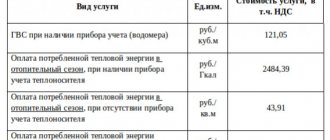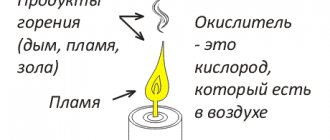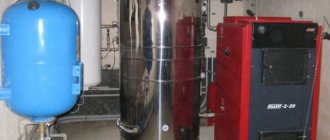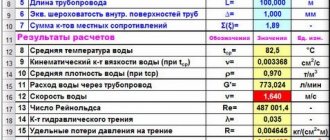Specific heat capacity of a substance
This value shows how much heat must be transferred to a body weighing one kilogram in order for its temperature to increase by one degree Celsius. Measured in J/(kg * ˚С). This value exists not because of its own whim, but because of the difference in the properties of various substances.
The specific heat of water is about ten times higher than the specific heat of iron, so the pan will heat up ten times faster than the water in it. It is curious that the specific heat capacity of ice is half that of water. Therefore, the ice will heat up twice as fast as water. Melting ice is easier than heating water. As strange as it may sound, it is a fact.
Units.
Converting heat units.
Heat calculator. Conversion of heat units (J, kJ, MJ, cal, kcal, Mcal, Gcal, erg, kWh, etc.)
Enter heat quantity (QQ)
Result of converting heat units (QQ)
The results of the heat calculator when converted to other heat units:
Examples of heat calculator results:
/ 1 Gcal = 1000000000 cal
//
10 kcal = 0.041868 MJ
//
1 Mcal = 4.1868 MJ
//
0 kWh = 0 Mcal
//
1 kcal = 238846000000 erg
//
0 Gcal = 0 Mcal
/
Share a link to the calculation:
HEAT TRANSFER
Heat transfer is the process of transferring heat within a body or from one body to another due to temperature differences. The intensity of heat transfer depends on the properties of the substance, the temperature difference and obeys the experimentally established laws of nature. To create efficiently operating heating or cooling systems, various engines, power plants, and thermal insulation systems, you need to know the principles of heat transfer. In some cases, heat exchange is undesirable (thermal insulation of smelting furnaces, spaceships, etc.), while in others it should be as large as possible (steam boilers, heat exchangers, kitchen utensils).
There are three main types of heat transfer: conduction, convection and radiant heat transfer.
Thermal conductivity.
If there is a temperature difference inside the body, then thermal energy moves from the hotter part of the body to the colder part. This type of heat transfer, caused by thermal movements and collisions of molecules, is called thermal conductivity; at sufficiently high temperatures in solids it can be observed visually. Thus, when a steel rod is heated from one end in the flame of a gas burner, thermal energy is transferred along the rod, and a glow spreads over a certain distance from the heated end (ever less intense with distance from the place of heating).
The intensity of heat transfer due to thermal conductivity depends on the temperature gradient, i.e. relationship D T
/D
x
temperature difference at the ends of the rod to the distance between them. It also depends on the cross-sectional area of the rod (in m2) and the thermal conductivity coefficient of the material [in the corresponding units of W/(mCHK)]. The relationship between these quantities was derived by the French mathematician J. Fourier and has the following form:
where q
is the heat flow,
k
is the thermal conductivity coefficient, and
A
is the cross-sectional area. This relationship is called Fourier's law of thermal conductivity; the minus sign in it indicates that heat is transferred in the direction opposite to the temperature gradient.
From Fourier's law it follows that heat flow can be reduced by reducing one of the quantities - thermal conductivity coefficient, area or temperature gradient. For a building in winter conditions, the latter values are practically constant, and therefore, in order to maintain the desired temperature in the room, it remains to reduce the thermal conductivity of the walls, i.e. improve their thermal insulation.
The table shows the thermal conductivity coefficients of some substances and materials. The table shows that some metals conduct heat much better than others, but all of them are significantly better conductors of heat than air and porous materials.
| THERMAL CONDUCTIVITY OF SOME SUBSTANCES AND MATERIALS | |
| Substances and materials | Thermal conductivity, W/(m×K) |
| Metals | |
| Aluminum | 205 |
| Bronze | 105 |
| Bismuth | 8,4 |
| Tungsten | 159 |
| Iron | 67 |
| Gold | 287 |
| Cadmium | 96 |
| Magnesium | 155 |
| Copper | 389 |
| Arsenic | 188 |
| Nickel | 58 |
| Platinum | 70 |
| Mercury | 7 |
| Lead | 35 |
| Zinc | 113 |
| Other materials | |
| Asbestos | 0,08 |
| Concrete | 0,59 |
| Air | 0,024 |
| Eider down (loose) | 0,008 |
| Tree nut) | 0,209 |
| Magnesia (MgO) | 0,10 |
| Sawdust | 0,059 |
| Rubber (sponge) | 0,038 |
| Mica | 0,42 |
| Glass | 0,75 |
| Carbon (graphite) | 15,6 |
The thermal conductivity of metals is due to vibrations of the crystal lattice and the movement of a large number of free electrons (sometimes called electron gas). The movement of electrons is also responsible for the electrical conductivity of metals, so it is not surprising that good conductors of heat (for example, silver or copper) are also good conductors of electricity.
The thermal and electrical resistance of many substances decreases sharply as the temperature drops below the temperature of liquid helium (1.8 K). This phenomenon, called superconductivity, is used to improve the efficiency of many devices, from microelectronics devices to power lines and large electromagnets.
Convection.
As we have already said, when heat is supplied to a liquid or gas, the intensity of molecular movement increases, and as a result, the pressure increases. If a liquid or gas is not limited in volume, then it expands; the local density of the liquid (gas) becomes smaller, and thanks to buoyancy (Archimedean) forces, the heated part of the medium moves upward (which is why the warm air in the room rises from the radiators to the ceiling). This phenomenon is called convection. In order not to waste the heat of the heating system, you need to use modern heaters that provide forced air circulation.
Convective heat flow from the heater to the heated medium depends on the initial speed of movement of molecules, density, viscosity, thermal conductivity and heat capacity and the medium; The size and shape of the heater are also very important. The relationship between the corresponding quantities obeys Newton's law
q = hA
(
TW - TҐ
),
where q
– heat flow (measured in watts),
A
– surface area of the heat source (in m2),
TW
and
TҐ
– temperatures of the source and its environment (in kelvins).
The convective heat transfer coefficient h
depends on the properties of the medium, the initial speed of its molecules, as well as on the shape of the heat source, and is measured in units of W/(m2CHK).
Value h
is not the same for the cases when the air around the heater is stationary (free convection) and when the same heater is in an air flow (forced convection).
In simple cases of fluid flow through a pipe or flow around a flat surface, the coefficient h
can be calculated theoretically. However, it has not yet been possible to find an analytical solution to the problem of convection for a turbulent flow of a medium. Turbulence is a complex movement of a liquid (gas), chaotic on a scale significantly larger than the molecular one.
If a heated (or, conversely, cold) body is placed in a stationary medium or in a flow, then convective currents and a boundary layer are formed around it. Temperature, pressure and the speed of movement of molecules in this layer play an important role in determining the coefficient of convective heat transfer.
Convection must be taken into account in the design of heat exchangers, air conditioning systems, high-speed aircraft and many other applications. In all such systems, thermal conductivity occurs simultaneously with convection, both between solid bodies and in their environment. At elevated temperatures, radiant heat transfer can also play a significant role.
Radiant heat transfer.
The third type of heat transfer - radiant heat transfer - differs from thermal conductivity and convection in that heat in this case can be transferred through a vacuum. Its similarity with other methods of heat transfer is that it is also caused by temperature differences. Thermal radiation is a type of electromagnetic radiation. Its other types - radio wave, ultraviolet and gamma radiation - arise in the absence of a temperature difference.
In Fig. Figure 8 shows the dependence of the energy of thermal (infrared) radiation on the wavelength. Thermal radiation can be accompanied by the emission of visible light, but its energy is small compared to the energy of radiation from the invisible part of the spectrum.
The intensity of heat transfer by conduction and convection is proportional to temperature, and radiant heat flow is proportional to the fourth power of temperature and obeys the Stefan–Boltzmann law
where, as before, q
is the heat flux (in joules per second, i.e. in W),
A
is the surface area of the radiating body (in m2), and
T
1 and
T
2 are the temperatures (in Kelvin) of the radiating body and the environment absorbing this radiation.
The coefficient s
is called the Stefan–Boltzmann constant and is equal to (5.66961±0.00096)Х10–8 W/(m2 ChK4).
The presented law of thermal radiation is valid only for an ideal emitter - the so-called absolutely black body. No real body is like this, although a flat black surface in its properties approaches an absolutely black body. Light surfaces emit relatively weakly. To take into account the deviation from ideality of numerous “gray” bodies, a coefficient less than unity, called emissivity, is introduced into the right side of the expression describing the Stefan-Boltzmann law. For a flat black surface this coefficient can reach 0.98, and for a polished metal mirror it does not exceed 0.05. Accordingly, the radiation absorption capacity is high for a black body and low for a mirror body.
Residential and office spaces are often heated with small electric heat emitters; the reddish glow of their spirals is visible thermal radiation, close to the edge of the infrared part of the spectrum. The room is heated by heat, which is carried mainly by the invisible, infrared part of the radiation. Night vision devices use a thermal radiation source and an infrared-sensitive receiver to allow vision in the dark.
The Sun is a powerful emitter of thermal energy; it heats the Earth even at a distance of 150 million km. The intensity of solar radiation recorded year after year by stations located in many parts of the globe is approximately 1.37 W/m2. Solar energy is the source of life on Earth. The search for ways to use it most effectively is underway. Solar panels have been created to heat houses and generate electricity for domestic needs.









